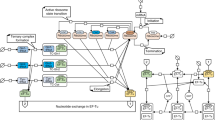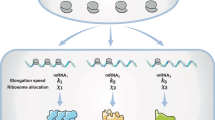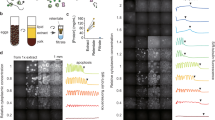Abstract
GROWTH of cells implies a net accumulation of intracellular proteins with the rate of protein synthesis exceeding the rate of protein degradation. It follows that the seemingly uncontrolled growth of transformed cells could be produced by a reduction in intracellular proteolysis without any concomitant increase in protein synthesis. In order to examine this hypothesis we have determined the rates of protein degradation in two pairs of (non-isogenic) cell types—non-growing rat liver hepatocytes and the chemically transformed Reuber H35 hepatoma, and mouse BALB/c 3T3 fibroblasts and 3T3 fibroblasts transformed with Simian Virus 40 (SV40). We have measured proteolysis over a wide range of insulin concentrations with cells incubated in either an enriched medium or a basal salts medium (step-down conditions). Insulin was chosen because it inhibits intracellular proteolysis in several cell types1–6 and may have a major role in the normal regulation of proteolysis in vivo. We report here that transformed cells have a lower basal rate of proteolysis together with an increased sensitivity towards inhibition by insulin, two factors which will contribute to the rapid growth of such cells.
This is a preview of subscription content, access via your institution
Access options
Subscribe to this journal
Receive 51 print issues and online access
$199.00 per year
only $3.90 per issue
Buy this article
- Purchase on Springer Link
- Instant access to full article PDF
Prices may be subject to local taxes which are calculated during checkout
Similar content being viewed by others
References
Goldberg, A. L. & Dice, J. F. A. Rev. Biochem. 43, 835–869 (1974).
Goldberg, A. L. & St John, A. C. A. Rev. Biochem. 45, 747–803 (1976).
Hershko, A., Mamont, P., Shields, R. & Tomkins, G. M. Nature new Biol. 232, 206–211 (1971).
Knowles, S. E. & Ballard, F. J. Biochem. J. 156, 609–617 (1976).
Gunn, J. M., Ballard, F. J. & Hanson, R. W. J. biol. Chem. 251, 3586–3593 (1976).
Mortimore, G. E. & Mondon, C. E. J. biol. Chem. 245, 2375–2383 (1970).
Poole, B. & Wibo, M. J. biol. Chem. 248, 6221–6226 (1973).
Berry, M. N. & Friend, D. S. J. Cell Biol. 43, 506–520 (1969).
Eagle, H. Science 130, 432–437 (1959).
Knowles, S. E., Gunn, J. M., Hanson, R. W. & Ballard, F. J. Biochem. J. 146, 595–600 (1975).
Pitot, H. C., Peraino, C., Morse, P. A., Jr. & Potter, V. R. Natn. Cancer Inst. Monogr. 13, 229–242 (1964).
Todaro, G. J. & Green, H. J. Cell Biol. 17, 299–313 (1963).
Todaro, G. J., Green, H. & Goldberg, B. D. Proc. natn. Acad. Sci. U.S.A. 51, 66–73 (1964).
Terris, S. & Steiner, D. F. J. biol. Chem. 250, 8389–8398 (1975).
Hollenberg, M. D. & Cuatrecasas, P. J. biol. Chem. 250, 3845–3853 (1975).
Author information
Authors and Affiliations
Rights and permissions
About this article
Cite this article
GUNN, J., CLARK, M., KNOWLES, S. et al. Reduced rates of proteolysis in transformed cells. Nature 266, 58–60 (1977). https://doi.org/10.1038/266058a0
Received:
Accepted:
Published:
Issue Date:
DOI: https://doi.org/10.1038/266058a0
This article is cited by
-
The role of autophagy in cancer development and response to therapy
Nature Reviews Cancer (2005)
-
Autophagy as a cell death and tumor suppressor mechanism
Oncogene (2004)
-
Insulin inhibition of protein degradation in cells expressing wild-type and mutant insulin receptors
Journal of Endocrinological Investigation (2003)
-
Induction of autophagy and inhibition of tumorigenesis by beclin 1
Nature (1999)
-
Protein degradation in lysosomes from chemically induced malignant rat hepatoma
Virchows Archiv B Cell Pathology (1988)
Comments
By submitting a comment you agree to abide by our Terms and Community Guidelines. If you find something abusive or that does not comply with our terms or guidelines please flag it as inappropriate.



